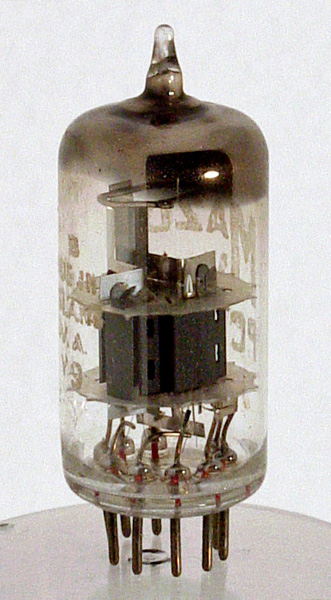|
PCC84Sensibly equivalent¶ to:See also:
|
|
|

|
The PCC84 double triode shows how valves developed to meet the needs of VHF television transmission.The PCC84 and PCF80 both featured in set-top converters for the new ITV television Band III channels that commenced broadcasting in 1955. The transmissions were on around 170 MHz and much higher in frequency than the BBC Band I signals at around 50 MHz.The PCC84 was specifically designed for cascode operation. The normal configuration was for triode one to be operated as a grounded cathode stage directly coupled to triode two. Triode two was connected as a grounded grid stage.The triode has a smaller inter electrode capacitance than a pentode at VHF and could be made physically small. The photograph shows that within the envelope the electrodes are a small percentage of the total volume. The two triodes would be used for initial signal amplification at up to 220 MHz. The low anode voltage and relatively high current being features to ensure low noise operation. The anode dissipation was two Watts for one triode or 2.5 Watts for both triodes operating.See also PCF80 for the corresponding oscillator and mixer.The thin glass tube envelope is 18 mm in diameter and, excluding the B9A base pins, is 45 mm tall.References: Data-sheet & 1040 Type PCC84 was first introduced in 1953. See also 1953 adverts. |
Pin Connections
| 1 | 2 | 3 | 4 | 5 | 6 | 7 | 8 | 9 |  k(2) | g1(2),s | a(2) | h | h | g1(1) | k1-in | k1-out | a(1) |
|
|
Absolute Maximum Operating Conditions¶
| Vh | Ah | Va | Vg | mAa | ra | gm | 
| 7.0 | 0.3 | 90 | -1.5 | 12 | 4000 | 6 |
|
Updated October 23, 2013.
|
|